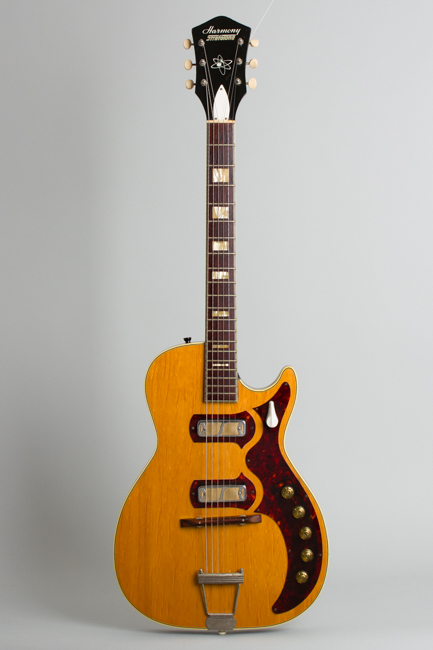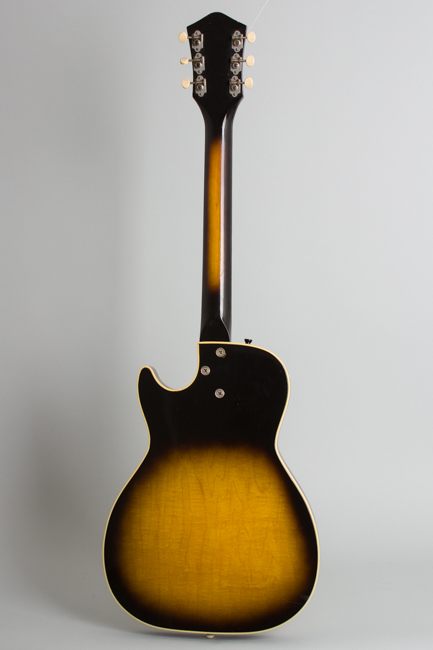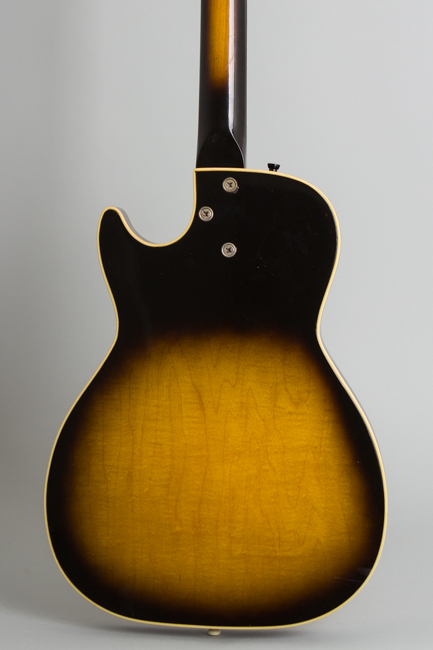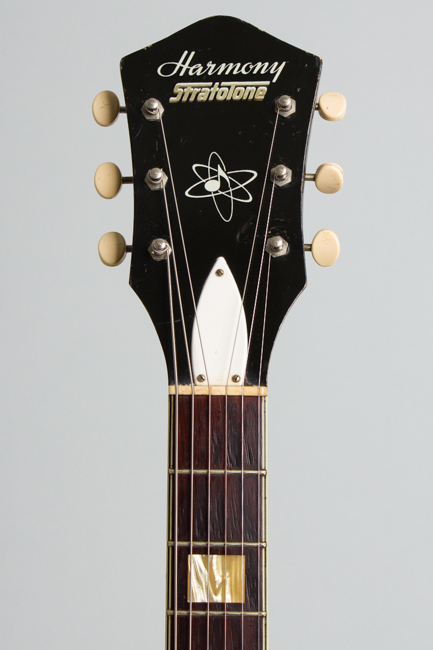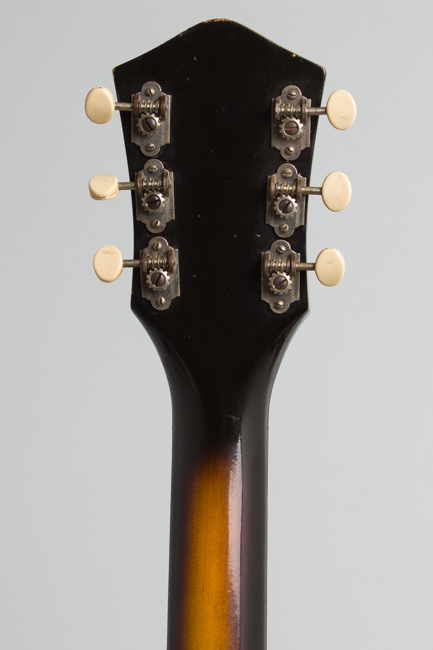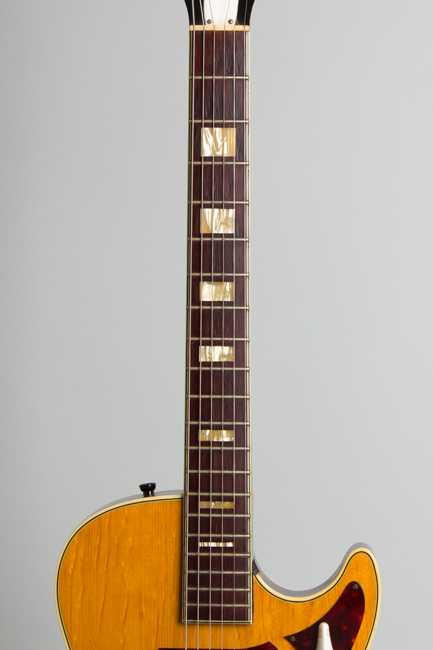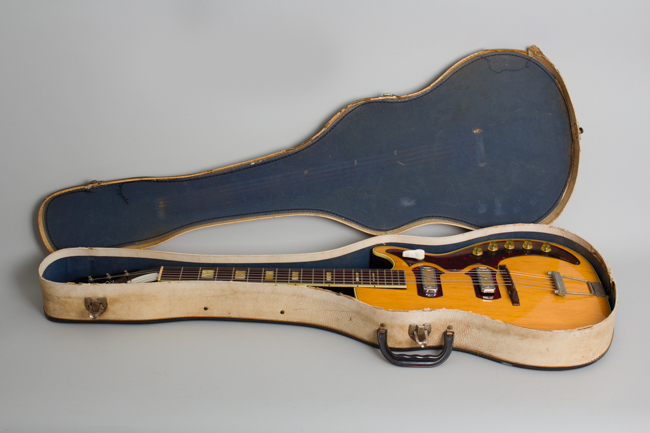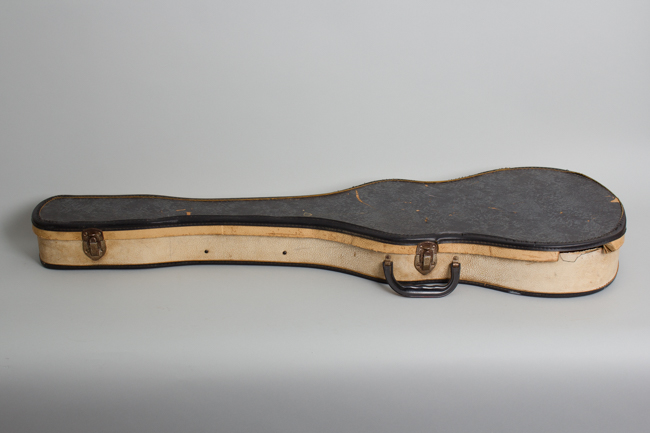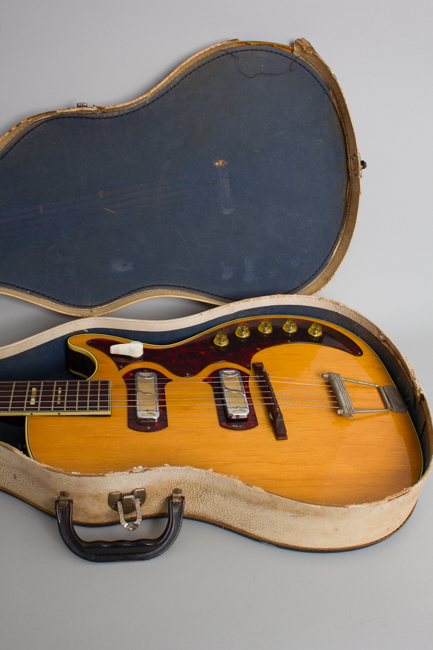Harmony Stratotone Jupiter Semi-Hollow Body Electric Guitar (1961)
Harmony Stratotone Jupiter Model Semi-Hollow Body Electric Guitar (1961), made in Chicago, natural top, sunburst back finish, laminated maple body with spruce top, maple neck with rosewood fingerboard, original two-tone chipboard case.
The Harmony Stratotone Jupiter is a super cool mid-level semi-hollow guitar most popular in the early 1960's. Priced at just a few dollars less than a Fender Esquire, it was actually a fairly high end piece for Harmony, the top of their new "semi-solid" line introduced in 1958. This one dates to 1961 (the pots date to the 6th week of that year) and is essentially unchanged from the original 1958 model.
The "Harmony Stratotone" logo on the headstock sits over a nifty atomic musical note motif. The maple neck has a triple-bound rosewood fingerboard with pearloid block inlay and a functional truss rod, something earlier Harmony instruments lacked. The small hollow maple body is capped with a triple bound, natural finished flat spruce top sporting tortoise celluloid pickguard accents.
Fitted with two great-sounding DeArmond "Golden Indox" pickups, this guitar has plenty of sonic possibilities with tone and volume controls for each pickup and a fifth "blend" knob provided when both are engaged. Harmony advertised it thusly: "Practically unlimited variations of tone, with simplified technique!" Although we cannot quite advertise the pickup circuit as being exactly intuitive, it is fully functional with a conventional 3-way lever switch plus the "exciting Blender" control setting.
This model was prominently featured in the mid-1960s by Spencer Davis of the Spencer Davis Group, but in general was popular with semi-pro and garage bands everywhere. This is a neat and practical design, very comfortable to play and one of Harmony's best 1960s offerings.
Overall length is 38 1/4 in. (97.2 cm.), 13 1/4 in. (33.7 cm.) wide at lower bout, and 1 7/8 in. (4.8 cm.) in depth, measured at side of rim. Scale length is 24 in. (610 mm.). Width of nut is 1 3/4 in. (44 mm.).
Overall this is a nicely preserved and quite playable example. It remains all original with some light wear overall, and the name "J.D.McDonald" inconspicuously etched into the top above the pickups. There is a deep scrape into the wood on the side at the apex of the upper bass bout caused by it rubbing against the brad on the inside of the case for years. Aside from this and some small dings and dents overall this is one of the nicer of these as we have had. It plays well and sounds great, complete in its worn but functional original chipboard case. Overall Excellent - Condition.
The Harmony Stratotone Jupiter is a super cool mid-level semi-hollow guitar most popular in the early 1960's. Priced at just a few dollars less than a Fender Esquire, it was actually a fairly high end piece for Harmony, the top of their new "semi-solid" line introduced in 1958. This one dates to 1961 (the pots date to the 6th week of that year) and is essentially unchanged from the original 1958 model.
The "Harmony Stratotone" logo on the headstock sits over a nifty atomic musical note motif. The maple neck has a triple-bound rosewood fingerboard with pearloid block inlay and a functional truss rod, something earlier Harmony instruments lacked. The small hollow maple body is capped with a triple bound, natural finished flat spruce top sporting tortoise celluloid pickguard accents.
Fitted with two great-sounding DeArmond "Golden Indox" pickups, this guitar has plenty of sonic possibilities with tone and volume controls for each pickup and a fifth "blend" knob provided when both are engaged. Harmony advertised it thusly: "Practically unlimited variations of tone, with simplified technique!" Although we cannot quite advertise the pickup circuit as being exactly intuitive, it is fully functional with a conventional 3-way lever switch plus the "exciting Blender" control setting.
This model was prominently featured in the mid-1960s by Spencer Davis of the Spencer Davis Group, but in general was popular with semi-pro and garage bands everywhere. This is a neat and practical design, very comfortable to play and one of Harmony's best 1960s offerings.
Overall length is 38 1/4 in. (97.2 cm.), 13 1/4 in. (33.7 cm.) wide at lower bout, and 1 7/8 in. (4.8 cm.) in depth, measured at side of rim. Scale length is 24 in. (610 mm.). Width of nut is 1 3/4 in. (44 mm.).
Overall this is a nicely preserved and quite playable example. It remains all original with some light wear overall, and the name "J.D.McDonald" inconspicuously etched into the top above the pickups. There is a deep scrape into the wood on the side at the apex of the upper bass bout caused by it rubbing against the brad on the inside of the case for years. Aside from this and some small dings and dents overall this is one of the nicer of these as we have had. It plays well and sounds great, complete in its worn but functional original chipboard case. Overall Excellent - Condition.
